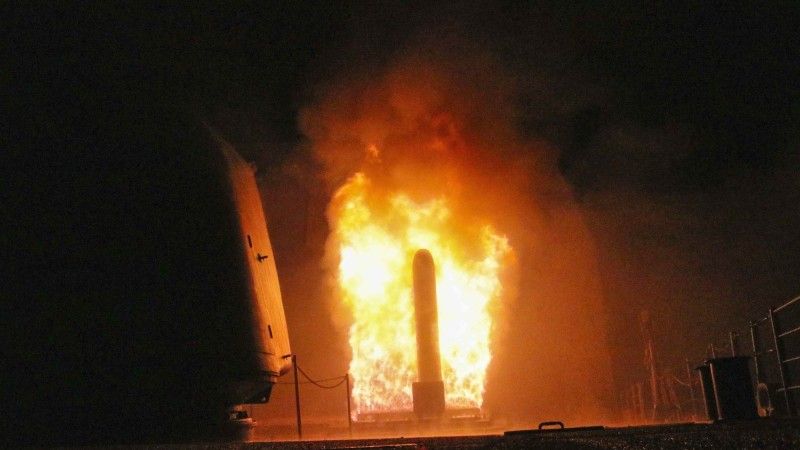Russian Nukes in Belarus vs. Possible NATO Responses [4 SCENARIOS]

Photo. Fot. Lt. j.g. Matthew Daniels/US Navy
The deployment of Russian nuclear weapons to Belarus would influence the security situation for the NATO members, especially the Eastern Flank nations. Possible scenarios of response that could be adopted by the allies are worth to be considered.
Vladimir Putin, in his interview for Rossiya-24 on Saturday, said that he is going to address Lukashenko's request for support with tactical nuclear weapons. Minsk already received 10 nuclear-capable aircraft, the Iskander system, while construction works on a storage facility for nuclear weapons are to be completed on 1st July. In practical terms, all conditions are met, required for the Russian nuclear weapons to be deployed to Belarus.
This should cause a relevant reaction in NATO. And what the said reaction could be? There are several possible variants, including:
1) Keeping the existing nuclear stance intact, focusing on conventional assets. This is a kind of a "0" variant - leaving any new actions aside, when it comes to nuclear deterrence posture, and focusing on conventional assets - this may be a plausible scenario, even if this variant is not the optimal one. Those supporting this course of action may suggest that NATO is modernizing its capabilities by integrating the F-35A with the B-61-12 bombs (some estimates give them 100 km range). Russia, meanwhile, is using nuclear weapons to compensate for its weaknesses. Even in this case, it would be necessary to bolster the air defences, and the conventional strike assets, as well as the ISR domain. All of that would make it more challenging for the Russians to conduct a possible strike on one hand, and get a chance to prepare nuclear deterrence assets of their own on the other. Let us add that NATO, at least following its new strategic concept, clearly indicates that the use of any nuclear weapons against the alliance would fundamentally change the nature of the conflict, while the Alliance's response, by assumption, would throw any related benefits out of the hand of the adversary. Some analysts suggest that strategic weapons could be used as a response asset here, as "any use of nuclear weapons is of strategic importance".

Photo. MoD UK/Crown Copyright
2) Reinforcement of the NATO Nuclear Sharing system and nuclear deterrence - by the participating nations. Another possible variant is the changed nuclear deterrence posture, aimed at reinforcing the capabilities of nations who are in possession of nuclear weapons, or who are a part of NATO Nuclear Sharing. That may involve an increase in the number of modernized B61-12 bombs stored in Europe for instance. These could be stored at RAF Lakenheath for instance - where proper infrastructure exists, and the F-35 jets are stationed. Another option is for the nations who already remain in possession of nuclear weapons - these could introduce new delivery measures. The United States could deploy Trump's favorite and Biden's less-than-favorite SLCM-N missile, designed for being launched by submarines.
Read more
A system as such would replace the nuclear Tomahawks that have been unilaterally decommissioned (and that was not New START's requirement, since that treaty referred to the strategic weapons, let's not forget that!) by Obama's administration post-2010. The implementation of that missile would reinforce the USA's negotiation stance in future talks on decommissioning nuclear weapons, also making it more challenging to plan an attack against the US allies - both in the European, as well as Pacific theater. Another alternative route could envisage the UK's return to the Nuclear Sharing system. That would require London to procure the F-35As (F-35Bs in the STOVL variant are not nuclear capable). Alternatively, the UK could use the SLCM-N missiles on its nuclear submarines, if the United States decides to do so.

3) Introduction of new states into the NATO Nuclear Sharing system. The third possible option assumes that new states would join the NATO Nuclear Sharing scheme. That would be time-consuming, and require infrastructural expansion. On the other hand, that would also be a strong signal for Moscow. To make this decision tangible, the US would need to express political will, and consent should also be granted by the allies - and this may be difficult. Poland is listed as one of the possible candidates to join the Nuclear Sharing scheme. Warsaw has been working towards such a solution - MEP Robert Biedroń (The Left), and MP Stanisław Tyszka (Konfederacja) have recently endorsed the idea. The US, however, is opposing this course of events, not willing to deploy nuclear weapons on the territory of NATO member states admitted to the alliance post-1997. Theoretically, Norway or Denmark could join the Nuclear Sharing scheme (not being tied by this limitation) - unfortunately, those nations, when joining NATO, made a declaration on their lack of will to store allied nukes within their territories.
4) Major increase in the importance of nuclear weapons in the NATO and US planning effort. The last, but also the least probable scenario here is the increase of the role that nukes may have in the US and NATO defence planning schemes. Currently, the nuclear warheads are only used in specific weapons systems (B61, B81, ASMP missiles, SBMs launched by submarines and from silos, ALCMs, and SLCM-N in the future), specifically designed for that purpose. The expert discussion sometimes includes a postulate to deploy dual-use systems (like Russia), designed both for nuclear, and conventional weapons delivery. A solution as such has been proposed by Prof. Matthew Kroenig (Atlantic Council) a few years back, regarding the JASSM missiles. Considering the direction in which the NATO policy is evolving, when it comes to nuclear weapons, this is less than probable.
Read more
It is also clearly visible, that a broad spectrum of options exists when it comes to the possible deployment of nuclear weapons in Belarus. In each of the postulated variants, other elements would need to be tailored, ISR in particular (for early warning on the threats, allowing for an appropriate reaction), air defences (to make any strike far more challenging), and conventional strike systems (also making strikes as such far more challenging). It would be desirable to consider resilience measures (civil defence), especially in countries neighbouring Belarus.
Let us add: a declaration made by Putin on the deployment of nukes to Belarus should not be a surprise, even though it was propaganda-tied to the delivery of armor piercing (APFSDS) rounds with depleted Uranium for Ukraine (with Putin admitting that DU armor piercing rounds shall not be viewed as a WMD). The first signals of Russia's will to deploy nukes to Belarus emerged between 2021 and 2022, as the new Union State's military doctrine was adopted - mentioning the increased threat of war.

Right after the Russian invasion of Ukraine, Belarus held a referendum that became a foundation for changes in the Belorussian constitution, allowing for the deployment of nukes within the territory of that state. Lukashenko also said that he wants to receive nuclear weapons, if Poland and Lithuania get nukes, within the framework of NATO activities. Although no steps have been made aimed at delivering nuclear weapons for the NATO Eastern Flank members, it was announced, in mid-2022, that the Belorussian Su-25 jets (or Su-24M - as per other sources), would be tailored for carrying nuclear weapons. Minsk was also to receive the nuclear-capable Iskander missiles. These steps have been quite unprecedented. Declarations made by Putin are aligned with those.
Noteworthy, Belarus was a nukes-free state for quite some time. The return of all of the Russian nuclear delivery measures to the Russian Federation has been stipulated in the NATO-Russia Founding Act. Within that Act, NATO also declared its obligation not to deploy nuclear weapons to states admitted to the alliance post-1997. The Russian propaganda, and Putin himself, claim that the deployment of tactical nuclear weapons in another country is a move that symmetrically reflects steps taken by NATO.
One should note however, that back in the 1990s, the USA, and the NATO nations, unilaterally withdrew all ground-based non-strategic nuclear delivery assets (including tactical missiles), and naval assets as such (Tomahawk) in 2013. Solely assets that can be carried by aircraft are left. Russia had, and still has, and still develops ground-based and naval missiles (Tochka-U system first, then Iskanders, and Kalibr missiles in the naval domain). Russia, and NATO as well, undertook their obligations to implement reductions in tactical nukes in the 1990s. For at least several years now, Russia has been expanding its arsenal. A bit more than a decade ago, the United States have begun further, voluntary cuts (decommissioning of the nuclear-capable Tomahawk missiles).

Photo. Mass Communication Specialist 3rd Class Joshua Fulton
All signs seem to suggest that Belarus is about to become a part of the Russian system used for using tactical nuclear weapons. At least, by sharing the capability of dual-use delivery systems, or through physical storage of nukes within its territory. For now, as John Kirby, spokesman for the US National Security Council, no information emerged on the physical movement of the warheads. That may happen, however, when the construction works regarding the storage facility are completed.
For the sake of clarity, it should be added that both "dual use" systems (capable of delivering both nuclear, as well as conventional payload), as well as storage facilities for ongoing storage of nuclear warheads, along with the infrastructure, have now been present in the Kaliningrad Oblast for quite some time - they are also being upgraded and modernized. No confirmed data suggests that Kaliningrad is used to store nuclear weapons, despite the district's readiness to do that. Some signals from Russia suggested (for instance Dmitry Medvedev) that the nukes would be redeployed there.
The decision to deploy nuclear weapons to Belarus breeches the disarmament consensus that remained valid since the 1990s. Still, we do not know the scale of the planned efforts. It is also relevant whether the "tactical" warheads would be stored within the system subordinated to the 12th Main Directorate of the MoD (as it happens in the case of the warheads stored in Russia), or they are handed over to units deployed in the region for exercises. The latter would translate into a serious shortening of the nuclear decision-making chain, thus also shortening the warning time. Certainly, including Belarus in the deterrence scheme solidifies Minsk's presence in Moscow's orbit of military and political influences.
US and NATO's reaction to the Russian plans for the deployment of nuclear weapons to Belarus depends on many factors, including the scope to which those plans may be implemented (whether the deployment includes warheads, or just the infrastructure, and the dual-use systems). The NATO nuclear weapons policy has been evolving since 2014. For instance, the Eastern Flank nations (Poland, Czech Republic, Romania, Hungary) have become a part of the SNOWCAT (Support of Nuclear Operations With Conventional Air Tactics) exercises - supporting the Steadfast Noon nuclear deterrence exercises, with conventional sorties.
As usual in the case of nuclear weapons, less or more open conflicts may arise among the allies, or even internally, in the US. However, similar events were also unfolding during the Cold War. The 2024 presidential election would be relevant here. The Republicans, traditionally, are placing their bets on reinforcement of the deterrence measures, with strong isolationist trends present among them.
For now, it can be said that the Russian and Belorussian actions have been planned in advance, as an element of a broader operation aimed at expanding the CEE region's influence, and the armed aggression against Ukraine is a key element of that operation. Holistically speaking, the NATO, US, and Polish reaction has been adequate, with proper deterrence measures implemented, and relevant support provided to Ukraine.





